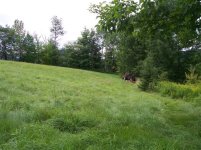turnkey4099
Elite Member
cmhyland said:Harry,
Your a man on a mission... Do you want to fly up to Connecticut and help me stack some wood?
As for all woods putting out the same btus per pound that makes some sense.. Dense woods weigh more and burn longer....
Regards,
Chris
Well, a mission sorta. I am working out about a 5 acre patch that a fire went through several years ago. Willow that is left standing after it dies goes to pot in a hurry so I have been cutting a _lot_ more than I normally would to salvage it first. Just about done with that patch and will have to look for another one someplace.
Yeah, that btu/pound thing - first time I saw it I had to scratch my head and think about it before I got it.
You spring for the ticket or the beer and I'll be there. The ticket would probably be cheaper in the long run
I am heavily retired and 'wooding' is my recreation and physical excercise. If it werent' for that I would probably be dead by now. Most of that stack of wood you saw was split the old way by hand. I only use the splitter for the diffictult stuff, knots, crotches, etc. or when I have to get the truck unloaded so I can use it. I was real concerned a few years ago (4?) when the doc told me I needed two artificial hips. That has been taken care of and it didn't slow me down at all.
bullridin_fool: Thanks. That was my guess and even went back to check but you had thrown in "full cords" prior so....
Harry K



